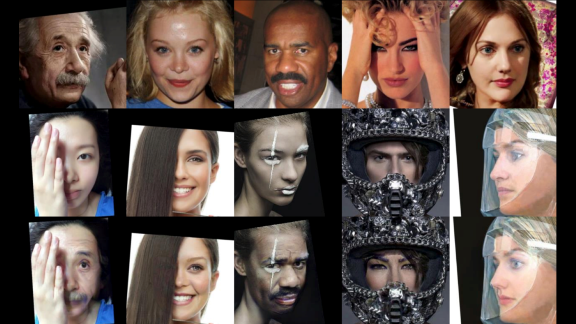AI’s ability to transfer a person’s face from a source photo onto someone in a target photo doesn’t work so well when the target face is partially obscured by, say, eyeglasses, a veil, or a hand. A new technique handles such occlusions.
What’s new: Lingzhi Li at Peking University and collaborators at Microsoft Research propose FaceShifter, a face-swapping system that reproduces accurately both a source face and elements that block the target.
Key insight: It’s easier to reproduce occlusions if you’ve scoped them out ahead of time. FaceShifter takes an extra step to identify occlusions before it renders the final image.
How it works: The system has two major components. Adaptive Embedding Integration Network (AEI-Net) spots occlusions and generates a preliminary swap. Heuristic Error Acknowledging Refinement Network (HEAR-Net) then refines the swap.
- AEI-Net identifies troublesome occlusions by using the target image as both source and target. The difference between its input and output highlights any occlusions it failed to reproduce.
- AEI-Net extracts face features from a source image. It learns to extract non-face features from the target image in multiple resolutions, so it can capture larger and smaller shapes.
- AEI-Net’s generator combines these features into an intermediate representation, using attention to focus on the most relevant features.
- HEAR-Net uses the occlusion-only and intermediate images to generate a final image. It’s trained to strike a balance between maintaining the source face’s distinctiveness, minimizing changes in AEI-Net’s output, and reproducing images accurately when the source and target are the same.
Results: The researchers used a pretrained face classifier to evaluate how well FaceShifter maintained the distinctiveness of the source face compared with DeepFakes and FaceSwap. FaceShifter achieved 97.38 percent accuracy versus 82.41 percent, the next-best score. It also outscored the other models in human evaluations of realism, identity, and attributes like pose, face expression, lighting.
Why it matters: FaceShifter introduces a novel method to check its own work. Although the researchers focused on swapping faces, a similar approach could be used to tackle challenges like combating adversarial examples.
We’re thinking: Better face swapping one day could transform entertainment by, say, grafting new stars — or even audience members — into movies. But it’s also potentially another tool in the arsenal of deepfakers who aim to deceive.

